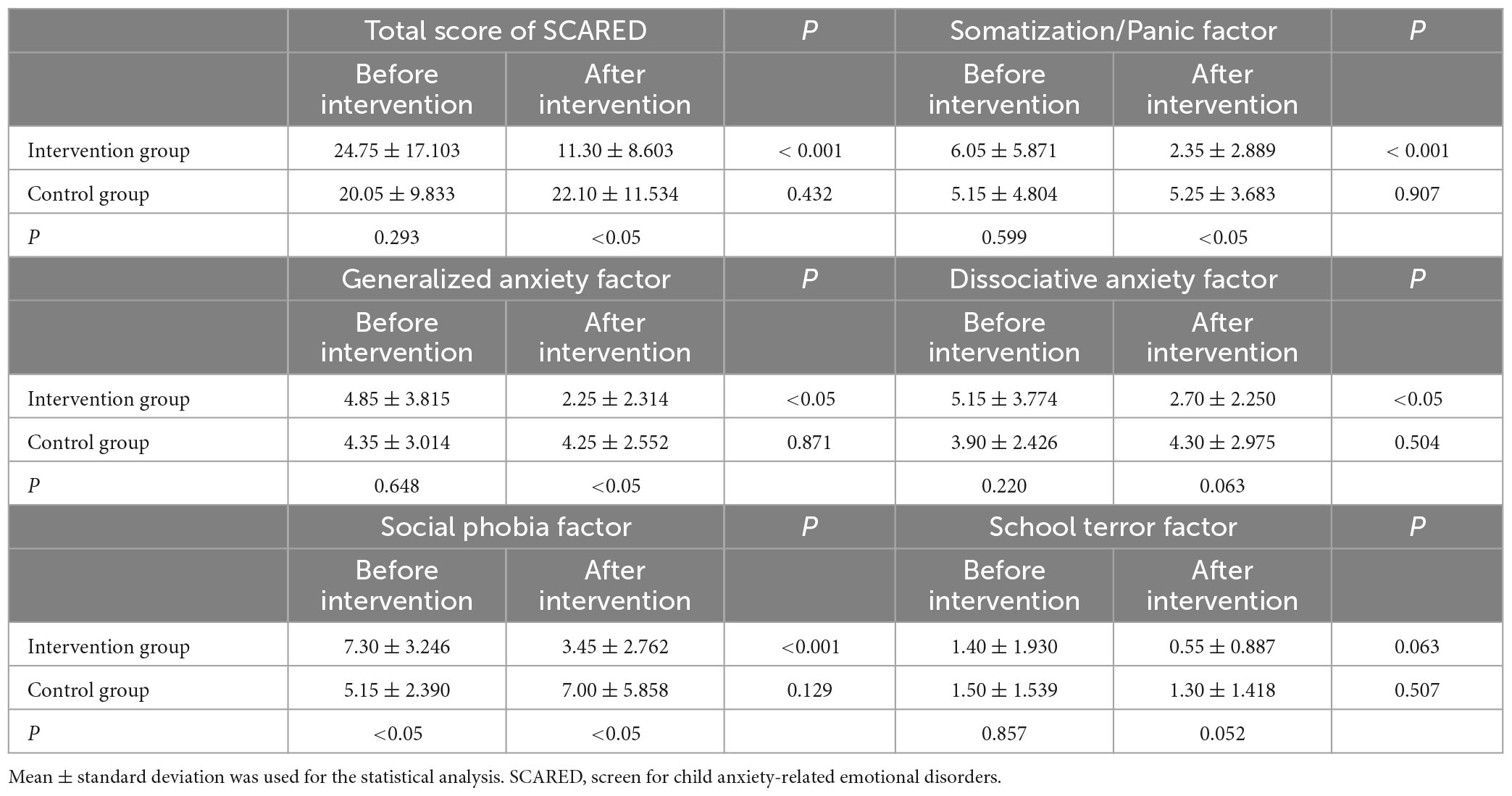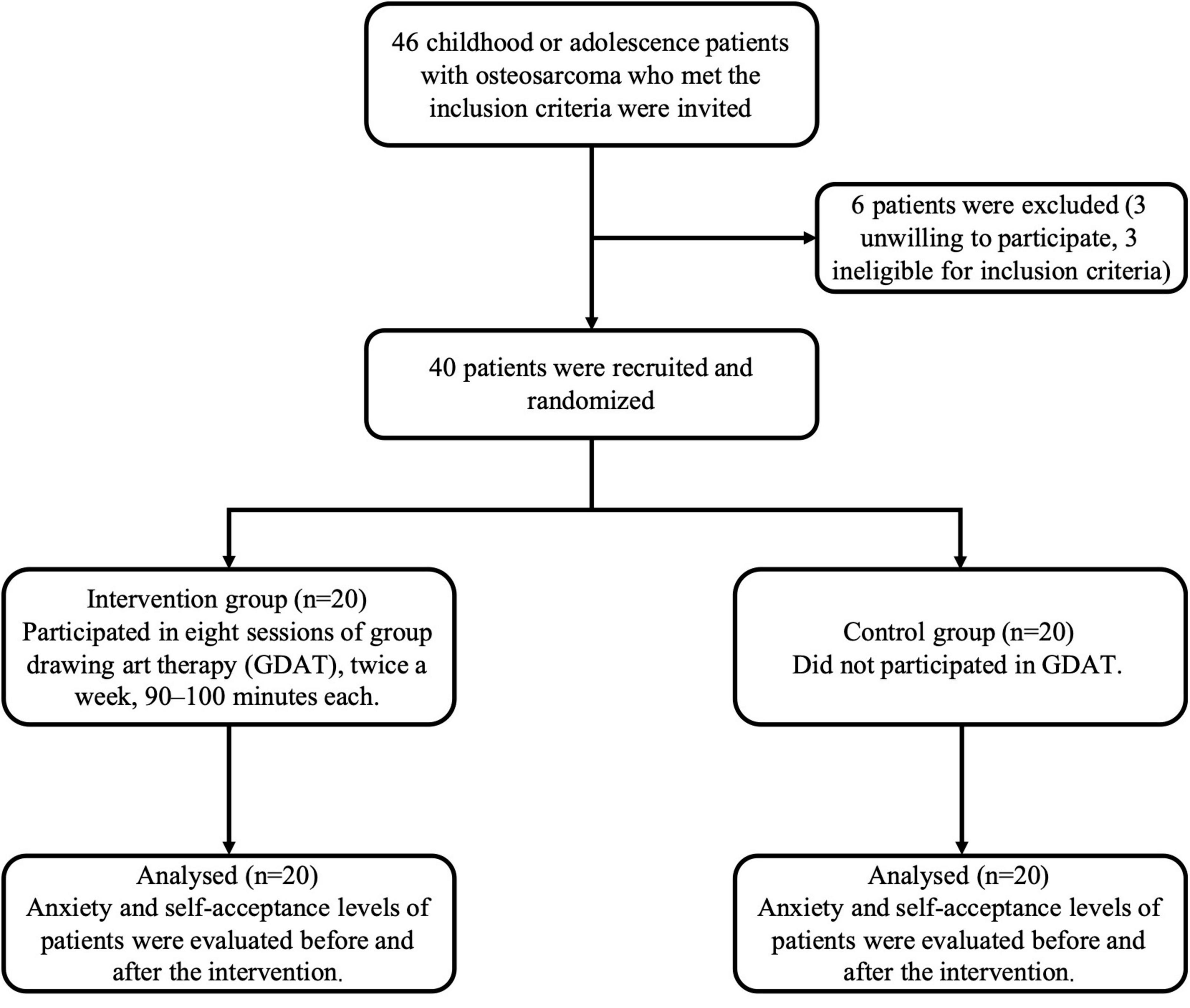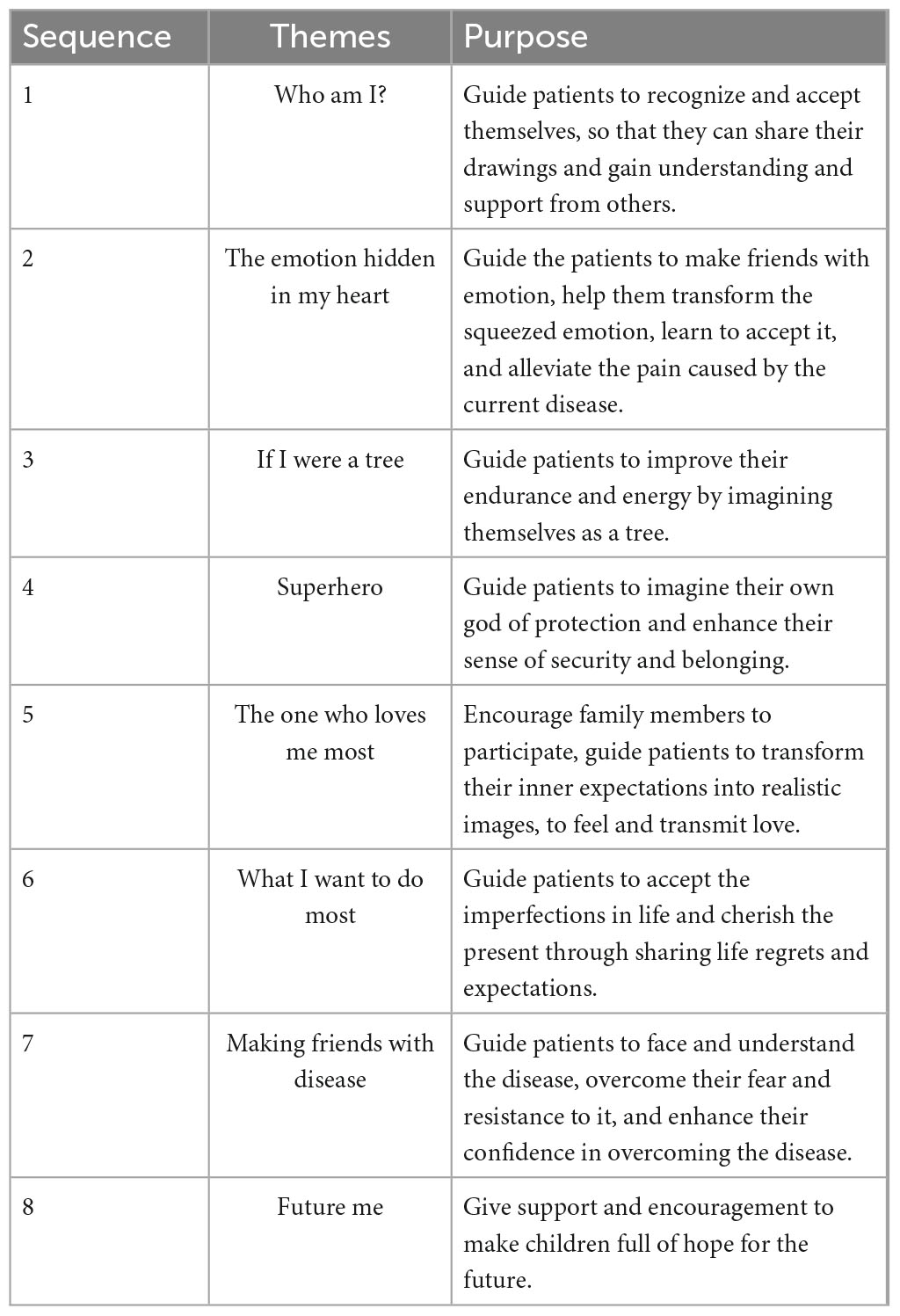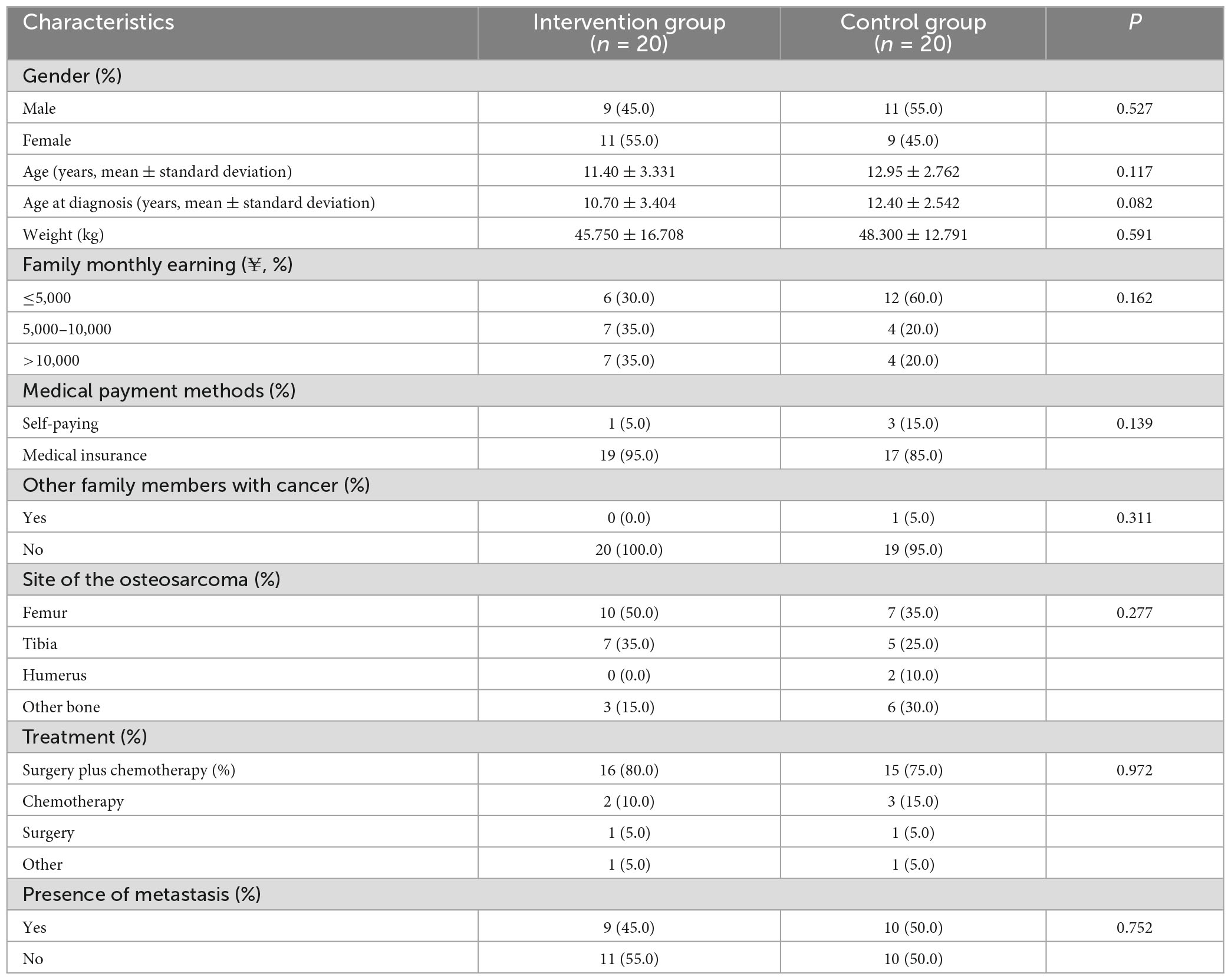- 1Department of Bone and Soft Tissue, The Affiliated Cancer Hospital of Zhengzhou University, Henan Cancer Hospital, Zhengzhou, Henan, China
- 2Zhengzhou Municipal Hospital of Pains on Neck-Shoulder-Waist, Zhengzhou, Henan, China
- 3Department of Integrated Chinese and Western Medicine, The Affiliated Cancer Hospital of Zhengzhou University, Henan Cancer Hospital, Zhengzhou, Henan, China
- 4Department of Nursing, The Affiliated Cancer Hospital of Zhengzhou University, Henan Cancer Hospital, Zhengzhou, Henan, China
Purpose: This study explored the effect of group drawing art therapy (GDAT) on anxiety and self-acceptance in children and adolescents with osteosarcoma.
Methods: Using a randomized experimental study design, 40 children and adolescents with osteosarcoma who were treated in our hospital from December 2021 to December 2022 were selected as the research objects, including 20 in the intervention group and 20 in the control group. The control group received routine care for osteosarcoma, while the intervention group participated in eight sessions of GDAT, twice a week, 90–100 min each, in addition to routine care for osteosarcoma. A screening for children’s anxiety disorders (SCARED) and a self-acceptance questionnaire (SAQ) were used to evaluate the patients before and after the intervention.
Results: After 8 weeks of GDAT, the SCARED total score in the intervention group was 11.30 ± 8.603, and that in the control group was 22.10 ± 11.534. The difference between the two groups was statistically significant (t = -3.357, P < 0.05). In the intervention group, the SAQ total score was 48.25 ± 4.204, with self-acceptance and self-evaluation factor scores of 24.40 ± 2.521 and 23.85 ± 2.434, respectively. In the control group, the SAQ total score was 42.20 ± 4.047; the self-acceptance factor score was 21.20 ± 3.350 and that of the self-evaluation factor was 21.00 ± 2.224. The differences between the two groups were statistically significant (t = 4.637, P < 0.001; t = 3.413, P < 0.05; t = 3.866, P < 0.001, respectively).
Conclusion: Group drawing art therapy can reduce anxiety and improve the levels of self-acceptance and self-evaluation in children and adolescents with osteosarcoma.
1. Introduction
Childhood and adolescence are important stages of physical and mental development and are prone to psychological and behavioral problems such as anxiety, low self-acceptance, low self-esteem, and social withdrawal (Lazor et al., 2021; Forrest et al., 2022). Anxiety disorders are characterized by symptoms of anxiety, fear, nervousness, and worry, as well as physical symptoms such as palpitations, shortness of breath, dizziness, and muscle tension (Birmaher et al., 1997; Lewandowska et al., 2021). Self-acceptance means that an individual can objectively accept and view himself, establish self-value based on self-recognition, respect and appreciate himself (Huang et al., 2021; Kelemen and Shamri-Zeevi, 2022). People with low self-acceptance develop psychological and behavioral problems such as low self-esteem and social withdrawal. Studies have shown that children and adolescents with cancer more likely to experience these psychological problems than those without cancer (Lewandowska et al., 2021; Raybin et al., 2022). Osteosarcoma is a severe teratogenic and fatal disease that occurs mainly in children and adolescents (Tian et al., 2020). Compared to patients with other non-teratogenic cancers, children and adolescents with osteosarcoma are bound to suffer greater psychological stress and may be more prone to psychological abnormalities (Lewandowska et al., 2021; Wu et al., 2022).
By providing information, support, and encouragement, healthcare providers and psychotherapists can help these children and adolescents cope with the rapidly changing psychological issues and challenges, thereby improving the effectiveness of cancer treatment and quality of life (Bar-Sela et al., 2007; Raybin et al., 2023). Interventions for this special type of patients should be professional, diverse, and in line with the developmental characteristics of children’s psychology (de Witte et al., 2021; Bekar et al., 2022; Cheng et al., 2022). Drawing art therapy refers to a non-linguistic psychotherapy technique that reflects an individual’s ability, personality, interests, concerns, and conflicts through painting, creative artistic activities, and their feedback on painting works. It can be used to improve the person’s cognitive level, cultivate self-esteem and self-awareness, augment emotional resilience, promote insight, enhance social skills, and reduce emotional conflict and psychological pain (Jiang et al., 2020; Zhang et al., 2022). Compared with traditional psychotherapy, drawing art therapy is not limited by language, age, place environment, cognitive ability, and disease. Furthermore, it is easily accepted by patients, with minimal resistance and simple treatment implementation, and is gradually being used in clinical treatment (Gürcan and Atay Turan, 2021; Raybin et al., 2022). Research has established that interventions using drawing art therapy have obvious effects in some individuals (Bar-Sela et al., 2007; Zhang et al., 2022).
Currently, there are no intervention studies on drawing psychotherapy for children and adolescents with osteosarcoma, which may be related to the low incidence of the disease. Consequently, this study aimed to intervene and guide children and adolescents with osteosarcoma by using group drawing art therapy (GDAT) for their low self-esteem, anxiety, and other emotions, to help them relieve their emotional and psychological problems during treatment.
2. Materials and methods
2.1. Participants
This is a randomized, controlled, non-blind clinical study. The consort diagram of this study is shown as Figure 1. In this study, child and adolescent patients with osteosarcoma who met the inclusion criteria were recruited from December 2021 to December 2022. Consequently, patients (1) aged 7–18, (2) diagnosed with osteosarcoma through pathological classification, and (3) who had undergone chemotherapy and surgery were included in the study. The exclusion criteria were as follows: (1) severe intellectual disability; (2) critical stage, myelosuppression stage, or with serious complications; and (3) past psychotherapy experience.
After being fully informed of the contents and procedures of GDAT and routine care, patients and their respective guardians signed an informed consent form. This study was approved by the Ethics Committee of Henan Cancer Hospital (approval number: 2021-KY-0176-003).
2.2. Procedure
The patients were randomly divided into control and intervention groups. Random assignment was carried out by an investigator who was blinded to the patient’s information. The study was conducted in a non-blinded condition, since the used instruments were self-report and children could not be blinded due to the nature of the painting therapy. The control group received routine nursing of osteosarcoma, while the intervention group received GDAT (Figure 1).
This study conducted GDAT on groups of 4–7 patients twice a week for 60–90 min. Each therapy session was divided into three stages: (1) a warm-up activity stage, which took approximately 20 min. In this stage, the psychotherapist led the patient to relax by playing ice-breaking games. (2) The theme drawing stage, of about 30–40 min, in which the drawing therapist introduced the scheduled drawing theme to the patients, and the patients drew freely. The content of the drawing was decided by the patient, without the therapist guiding it; the latter merely accompanied the patient to observe the order and content of the drawing. The intervention group received eight GDAT sessions; the themes are detailed in Table 1. The purpose was to guide patients to release various complex emotions generated during hospitalization through a creative process. (3) The ending stage took approximately 20 min. In this stage, the patients were guided to share their work, experience, feelings, and outcome of the drawing therapy, to relieve anxiety and reshape hope.
2.3. Evaluation
The patients’ age, age at diagnosis, weight, sex, family status, disease, and other basic information were recorded.
Patient anxiety was assessed using the Screen for Child Anxiety Related Emotional Disorders (SCARED) scale (Birmaher et al., 1997). The scale’s 41 items were divided into five factors: somatic panic, generalized anxiety, dissociative anxiety, social phobia, and school phobia. Each factor is scored at Level 3, with the options “do not have this problem,” “sometimes,” and “often” receiving 0, 1, and 2 points, respectively. The score for each item was added to obtain the total score of the scale. The higher the total score of the scale, the higher is the level of individual anxiety.
Patient self-acceptance was assessed using a self-acceptance questionnaire (SAQ; Cong and Gao, 1999; Chen et al., 2017). The SAQ was used to evaluate an individual’s acceptance level of their current state. The scale consists of 16 items, which can be divided into two factors: self-acceptance and self-evaluation. The scale adopts a Likert 4-level scoring method, with each item receiving from 1 (very same) to 4 (very opposite) points. The total score of the scale ranged from 16 to 64 points; the higher the score, the higher the level of self-acceptance.
The SCARED and SAQ scale scores were collected by two specially trained researchers before the first GDAT session and on the day after the end of the eighth GDAT session.
2.4. Statistical methods
This study employed the data collation software EXCEL (Microsoft, Redmond, WA, United States), which ensured the accuracy of the data through double entry. SPSS 21.0 (IBM, Amenk, NY, United States) was used for data analysis. The measurement data conformed to the normal distribution; the mean ± standard deviation was used for statistical description, while the frequency and constituent ratio of the counting data were used for statistical description. The measurement data were consistent with a normal distribution and homogeneity of variance. A paired t-test was used to compare intra-group differences, and a t-test of two independent samples was used to compare inter-group differences. The chi-square test was used to compare differences between the groups. The inspection level was considered α = 0.05.
3. Results
3.1. The basic characteristics of the groups
Forty patients aged 7–18 were included in this study. There were 20 boys and 20 girls, with an average age of 12.10 years. All the enrolled patients underwent chemotherapy or surgery combined with chemotherapy. There was no significant difference in the general data between the control group (20 patients) and the intervention group (20 patients; P > 0.05; Table 2).
3.2. SCARED scale scores comparison between the two groups before and after intervention
3.2.1. Intra-group comparison
The total scores of the SCARED (P < 0.001), somatization/panic factor (P < 0.001), generalized anxiety factor (P < 0.05), dissociative anxiety factor (P < 0.05), and social terror factor (P < 0.001) in the intervention group were significantly lower than those before the intervention (Table 3). The total scores of the SCARED, somatization/panic, generalized anxiety, dissociative anxiety, social phobia, and school phobia factors in the control group after the intervention were not significantly different from those before the intervention (P > 0.05).

Table 3. Screening for children’s anxiety disorders (SCARED) scale score comparison between the intervention and control groups.
3.2.2. Comparison between groups
Before intervention, there was no significant difference in the total scores of the SCARED, the somatization/panic, generalized anxiety, dissociative anxiety, and school terror factors between the two groups (P > 0.05). Before the intervention, the social phobia score in the intervention group was significantly higher than that in the control group (P < 0.05). After the intervention, the total scores on the SCARED (P < 0.05), somatization/panic (P < 0.05), generalized anxiety (P < 0.05), and social phobia (P < 0.05) factors in the intervention group were significantly lower than those in the control group. Although the scores of the dissociative anxiety and school terror factors in the intervention group were lower than those in the control group, the difference was not statistically significant (P > 0.05; Table 3).
3.3. SAQ score comparison between the two groups before and after intervention
3.3.1. Intra-group comparison
After the intervention, the SAQ total score (P < 0.001) and self-acceptance factor score (P < 0.001) in the intervention group were significantly higher than those before the intervention. Although the self-evaluation factor score in the intervention group after the intervention was higher than that before, the difference was not statistically significant (P > 0.005). The SAQ total score, and the self-acceptance and self-evaluation factor scores in the control group after the intervention were not significantly different from those before the intervention (P > 0.05; Table 4).

Table 4. Self-acceptance questionnaire (SAQ) score comparison between the intervention and control groups.
3.3.2. Comparison between groups
Before the intervention, there were no significant differences between the two groups in the total SAQ, self-acceptance, and self-evaluation scores (P > 0.05). After the intervention, the total scores of the SAQ scale (P < 0.001), self-acceptance factor (P < 0.05), and self-evaluation factor (P < 0.001) in the intervention group were significantly higher than those in the control group.
4. Discussion
This study found that after eight GDAT sessions, the total scores of the anxiety scale, and the scores for somatization/panic, generalized anxiety, and social phobia factors of children and adolescents with osteosarcoma in the intervention group were significantly lower than those in the control group. The total scores of the self-acceptance scale, and those on the self-acceptance and self-evaluation factors of children and adolescents with osteosarcoma in the intervention group were significantly higher than those in the control group.
Children and adolescent patients with osteosarcoma are more prone to anxiety due to their high degree of disease malignancy, rapid growth, early metastasis, poor prognosis, limb deformity, and pain (Lewandowska et al., 2021; Wu et al., 2022). Drawing therapy can use non-verbal visual arts to deeply explore individual emotions, touch patients’ inner subconscious, and correct unpleasant emotional experiences. It allows patients to develop symbolic language and learn new ways of expressing emotions (Bar-Sela et al., 2007; Bozcuk et al., 2017). GDAT enables patients to express various negative emotions that arise from being hospitalized and treated for illness—fear of illness, pain from illness and treatment, and anxiety about the uncertainty of physical recovery—through colors, lines, images, and stories. Consequently, the visible and invisible anxiety become a tangible and telling picture, and finally, the emotion itself weakens or disappears (Raybin et al., 2022; Zhang et al., 2022). Several studies have shown that different forms of drawing interventions can effectively reduce anxiety and depressive symptoms in adolescent cancer patients (Bozcuk et al., 2017; Forouzandeh et al., 2020; Gürcan and Atay Turan, 2021). The results of this study are consistent with those of previous research; that is, after eight sessions of group drawing therapy, the anxiety scale score of the treated patient was significantly reduced. In this study, the themed activities of “Who am I?” and “The emotion hidden in my heart” were used to guide patients to understand themselves and their emotions, release various complex emotions during hospitalization, dissolve pain and confrontation, and help them weaken or eliminate negative repressed emotions.
Studies have shown that cancer patients generally have a low level of self-acceptance (Li et al., 2010). Self-acceptance means that an individual can objectively accept and view himself, establish self-value based on self-recognition, respect and appreciate himself (Huang et al., 2021; Kelemen and Shamri-Zeevi, 2022). Adolescent cancer patients are more likely to doubt their own worth and lower their level of self-acceptance (Lewandowska et al., 2021). The results of this study are consistent with previous findings; that is, providing psychological intervention support to cancer patients can significantly improve their level of self-acceptance (Bozcuk et al., 2017; Zhang et al., 2022). The process of drawing can correct discordant cognition through abstract image thinking and imagination to promote and improve the painter’s cognitive function and the degree of self-acceptance (Huang et al., 2021). This study guides patients to think about how to get along with the disease, stabilize their inner state, explore their personality traits, accept life imperfections, improve self-esteem, and realize self-appreciation and self-acceptance through drawing themed activities such as “What I want to do most,” “Make friends with the disease,” and “Future me.”
In addition to anxiety and self-acceptance, previous studies have shown that drawing therapy can also help reshape the hope of cancer patients, promote energy conversion, and guide patients to love life (Collette et al., 2021; Zhang et al., 2022; Raybin et al., 2023). This study uncovered similar findings, thus demonstrating increased levels of hope remodeling in patients who received GDAT. For example, a 9 years-old patient drew a closed road for the first time, thus indicating the rejection of himself and despair for the future. After four group drawing therapy sessions, the patient drew a scene of the school raising the national flag, thereby suggesting that the person had high hopes of returning to school.
The major limitations of this study are the limited sample size and the fact that it was conducted at a single institution. In future multi-center, large-sample randomized controlled trials, children can be classified more carefully, and more individualized themes can be designed according to the actual situation to better adjust for children’s inner anxiety. In addition, this study did not use objective research tools to assess the level of hope remodeling in patients. Future studies should further evaluate the impact of GDAT on hope remodeling and the sense of happiness in patients with sarcoma through objective and evaluable indicators.
5. Conclusion
Eight sessions of GDAT can significantly reduce the anxiety level of children and adolescents with osteosarcoma, while significantly improving their self-acceptance. It demonstrates that it is an effective intervention that can be widely used in the treatment and nursing of children and adolescents with osteosarcoma.
Data availability statement
The original contributions presented in this study are included in the article/supplementary material, further inquiries can be directed to the corresponding author.
Ethics statement
The studies involving human participants were reviewed and approved by Ethics Committee of Henan Cancer Hospital (approval number: 2021-KY-0176-003). Written informed consent to participate in this study was provided by the participants’ legal guardian/next of kin.
Author contributions
XL and XX conceived and designed the study. XL, LS, CZ, and YZ collected, analyzed the data, and wrote the manuscript. XD and XX prepared the tables and revised the manuscript. All authors read and approved the submitted version.
Funding
This study was financially supported by the Scientific Research Project of Health Commission of Henan Province, China (Grant No. LHGJ20200165). The funder had no role in study design, data collection and data analysis, decision to publish, or preparation of the manuscript.
Acknowledgments
We thank all the children and adolescents with osteosarcoma who participated in this study, as well as their parents.
Conflict of interest
The authors declare that the research was conducted in the absence of any commercial or financial relationships that could be construed as a potential conflict of interest.
Publisher’s note
All claims expressed in this article are solely those of the authors and do not necessarily represent those of their affiliated organizations, or those of the publisher, the editors and the reviewers. Any product that may be evaluated in this article, or claim that may be made by its manufacturer, is not guaranteed or endorsed by the publisher.
References
Bar-Sela, G., Atid, L., Danos, S., Gabay, N., and Epelbaum, R. (2007). Art therapy improved depression and influenced fatigue levels in cancer patients on chemotherapy. Psychooncology 16, 980–984. doi: 10.1002/pon.1175
Bekar, P., Erkul, M., and Efe, E. (2022). The effect of using a kaleidoscope during central venous catheter dressing changes on pain and anxiety in children with cancer: A randomised controlled trial. Eur. J. Oncol. Nurs. 57:102114. doi: 10.1016/j.ejon.2022.102114
Birmaher, B., Khetarpal, S., Brent, D., Cully, M., Balach, L., Kaufman, J., et al. (1997). The screen for child anxiety related emotional disorders (SCARED): Scale construction and psychometric characteristics. J. Am. Acad. Child Psychiatry 36, 545–553.
Bozcuk, H., Ozcan, K., Erdogan, C., Mutlu, H., Demir, M., and Coskun, S. (2017). A comparative study of art therapy in cancer patients receiving chemotherapy and improvement in quality of life by watercolor painting. Complement. Ther. Med. 30, 67–72. doi: 10.1016/j.ctim.2016.11.006
Chen, S. Q., Liu, J. E., Zhang, Z. X., and Li, Z. (2017). Self-acceptance and associated factors among Chinese women with breast cancer. J. Clin. Nurs. 26, 1516–1523. doi: 10.1111/jocn.13437
Cheng, Z., Yu, S., Zhang, W., Liu, X., Shen, Y., and Weng, H. (2022). Virtual reality for pain and anxiety of pediatric oncology patients: A systematic review and meta-analysis. Asia Pac. J. Oncol. Nurs. 9:100152.
Collette, N., Guell, E., Farinas, O., and Pascual, A. (2021). Art therapy in a palliative care unit: Symptom relief and perceived helpfulness in patients and their relatives. J. Pain Symptom Manag. 61, 103–111. doi: 10.1016/j.jpainsymman.2020.07.027
Cong, Z., and Gao, W. (1999). The development of self-acceptance questionnaire and the test of its reliability and validity. Chin. J. Behav. Med. Sci. 8, 20–22.
de Witte, M., Orkibi, H., Zarate, R., Karkou, V., Sajnani, N., Malhotra, B., et al. (2021). From therapeutic factors to mechanisms of change in the creative arts therapies: A scoping review. Front. Psychol. 12:678397. doi: 10.3389/fpsyg.2021.678397
Forouzandeh, N., Drees, F., Forouzandeh, M., and Darakhshandeh, S. (2020). The effect of interactive games compared to painting on preoperative anxiety in Iranian children: A randomized clinical trial. Complement. Ther. Clin. Pract. 40:101211. doi: 10.1016/j.ctcp.2020.101211
Forrest, C. B., Schuchard, J., Bruno, C., Amaral, S., Cox, E. D., Flynn, K. E., et al. (2022). Self-reported health outcomes of children and youth with 10 chronic diseases. J. Pediatr. 246:e1.
Gürcan, M., and Atay Turan, S. (2021). The effectiveness of mandala drawing in reducing psychological symptoms, anxiety and depression in hospitalised adolescents with cancer: A randomised controlled trial. Eur. J. Cancer Care 30:e13491. doi: 10.1111/ecc.13491
Huang, C. Y., Su, H., Cheng, S. M., and Tan, C. S. (2021). The effects of group art therapy on adolescents’ self-concept and peer relationship: A mixed-method study. New Dir. Child Adolesc. Dev. 2021, 75–92. doi: 10.1002/cad.20435
Jiang, X. H., Chen, X. J., Xie, Q. Q., Feng, Y. S., Chen, S., and Peng, J. S. (2020). Effects of art therapy in cancer care: A systematic review and meta-analysis. Eur. J. Cancer Care 29:e13277. doi: 10.1111/ecc.13277
Kelemen, L. J., and Shamri-Zeevi, L. (2022). Art therapy open studio and teen identity development: Helping adolescents recover from mental health conditions. Children 9:1029. doi: 10.3390/children9071029
Lazor, T., De Souza, C., Urquhart, R., Serhal, E., and Gagliardi, A. R. (2021). Few guidelines offer recommendations on how to assess and manage anxiety and distress in children with cancer: A content analysis. Support. Care Cancer 29, 2279–2288. doi: 10.1007/s00520-020-05845-8
Lewandowska, A., Zych, B., Papp, K., Zrubcova, D., Kaducakova, H., Supinova, M., et al. (2021). Problems, stressors and needs of children and adolescents with cancer. Children 8:1173.
Li, H. C., Chung, O. K., and Chiu, S. Y. (2010). The impact of cancer on children’s physical, emotional, and psychosocial well-being. Cancer Nurs. 33, 47–54.
Raybin, J. L., Harnke, B., and Hendricks-Ferguson, V. (2022). Does creative arts therapy improve distressing symptoms in children with cancer? A synthesis of extant literature. J. Pediatr. Hematol. Oncol. Nurs. 39, 60–71. doi: 10.1177/27527530211059432
Raybin, J. L., Zhou, W., Pan, Z., Hendricks-Ferguson, V. L., and Jankowski, C. (2023). Creative arts therapy among children with cancer: Symptom assessment reveals reduced anxiety. Cancer Nurs. doi: 10.1097/NCC.0000000000001186
Tian, Z., Niu, X., and Yao, W. (2020). Receptor tyrosine Kinases in Osteosarcoma treatment: Which is the key target? Front. Oncol. 10:1642. doi: 10.3389/fonc.2020.01642
Wu, J., Meng, J., and Li, H. (2022). WeChat-platform-based education and care program as a candidate approach to relieve anxiety, depression, and post-traumatic stress disorder in parents of pediatric and adolescent patients with osteosarcoma. Front. Psychol. 13:913940. doi: 10.3389/fpsyg.2022.913940
Keywords: drawing, art therapy, osteosarcoma, anxiety, self-acceptance
Citation: Liu X, Sun L, Du X, Zhang C, Zhang Y and Xu X (2023) Reducing anxiety and improving self-acceptance in children and adolescents with osteosarcoma through group drawing art therapy. Front. Psychol. 14:1166419. doi: 10.3389/fpsyg.2023.1166419
Received: 15 February 2023; Accepted: 29 March 2023;
Published: 17 April 2023.
Edited by:
Helena José, Universidade Atlântica, PortugalReviewed by:
Maria Valle Ramirez-Duran, University of Extremadura, SpainHelga Oliveira, Universidade Atlântica, Portugal
Copyright © 2023 Liu, Sun, Du, Zhang, Zhang and Xu. This is an open-access article distributed under the terms of the Creative Commons Attribution License (CC BY). The use, distribution or reproduction in other forums is permitted, provided the original author(s) and the copyright owner(s) are credited and that the original publication in this journal is cited, in accordance with accepted academic practice. No use, distribution or reproduction is permitted which does not comply with these terms.
*Correspondence: Xiaoxia Xu, eHV4aWFveGlhenp1QDE2My5jb20=
 Xin Liu1
Xin Liu1 Xiaoxia Xu
Xiaoxia Xu

